Sponsored in Part By

By Charles & Linda Raabe
Mactan Island, The Philippines
© 2016 ALL RIGHTS RESERVED
I have never found a crab yet that has
hitchhiked into my tank that I would consider reef safe. The only crabs
that I consider to be truly reef safe are the commensal types such as
the porcelain crab and coral crabs. The only reason such
crabs can be considered reef safe is that they never leave their
hosting spot. The hermit crabs that are intentionally introduced to our
tanks are not to be trusted or considered reef safe either, all crabs
are omnivores and will eat what ever they can. While most corals are
safe from hermit types, other inverts and fleshy polyp corals are not.
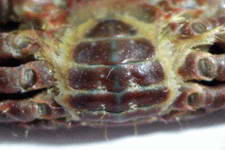

A Female crab (left) and a Male crab (right)
The Xanthidae Crabs
(link - extensive photo gallery) None of which can be
considered reef safe and can be the most destructive of the crab types.
While very small, they seem to pick at algae on the rocks, but just as
with other crabs species, once they gain a bit of size, their ability
to pick off and eat any number of invertebrates and corals also
increases. They also have a bad habit of enlarging their hiding places
within live rock and will, in due time, weaken the rock considerably.
Below, a commonly found Xanthid species living within live rock.
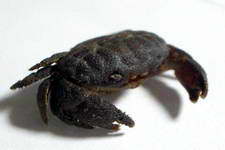
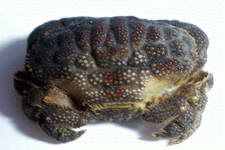
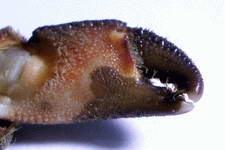
Below, yet another rock living Xanthid species.
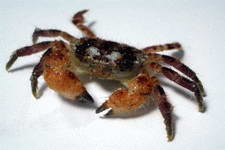
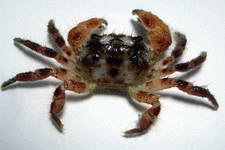

Below is a Xanthid species found on Acropora corals and assume they prey upon the corals polyps or tissue.
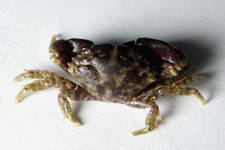
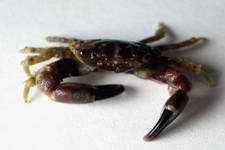

Various other Xanthid species.
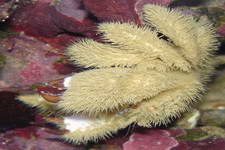

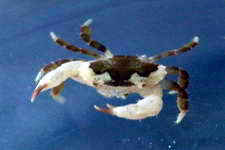
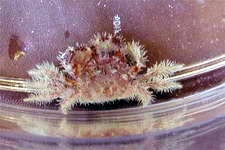

The Hermit Crabs Hermit ID site Paguritta Hermit Crab
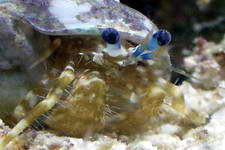
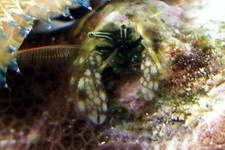
The Mithrax Crabs ( Cling Crabs) None of which I would consider to be reef safe, members of this family include the popular "emerald" crabs that are used for algae control, which may be fine for awhile, but with all crabs being omnivores, it is usually only a matter of time before these crabs discover that there are meatier items to be had within your aquarium.
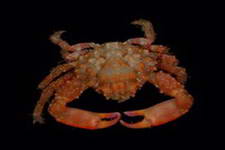
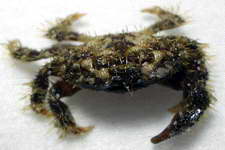

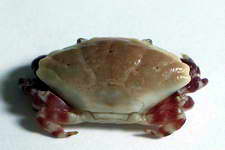
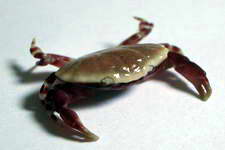


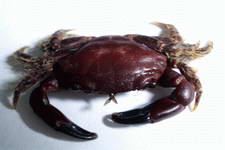
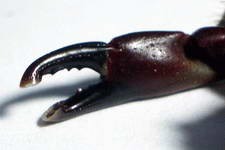
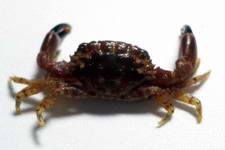


The Porcellanidae Crabs Photo Link #2 Photo Link #3 Can be considered Reef Aquarium Safe

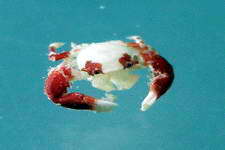
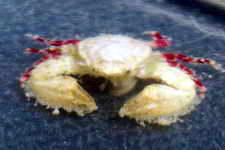
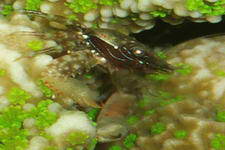

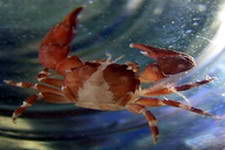
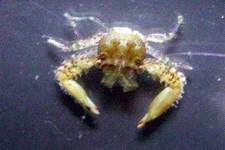
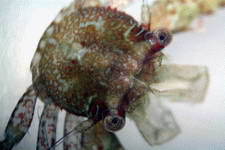

The Anomuran crabs, part of the Porcellanidae family, relatives of Petrolisthes and Porcellanella.
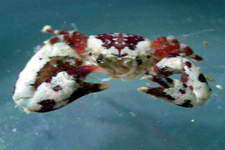
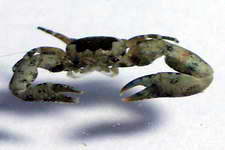

Petrolisthes species
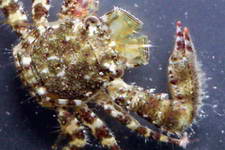
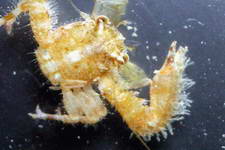
The Galatheid Crabs - Also known as squat lobsters for their appearing very lobster like. All of the species that I have found on live rock have been very small and seem to be somewhat harmless, although they may feed upon small sessile invertebrates.
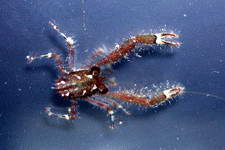
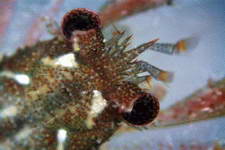
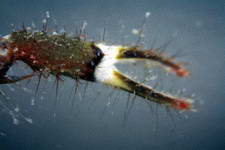

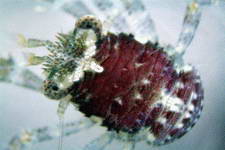
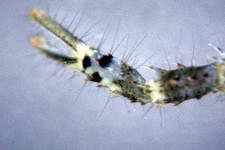
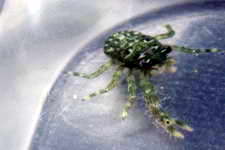

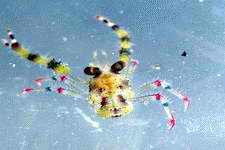
The Allogalatheid Crabs - also known as squat lobsters but only lives on crinoids. Color patterns usually consists of alternating dark & light colored bands with white leg tips & claws; the colors always match the host crinoid. They are klepto-parasites that don't directly harm the host but steal its food.
Allogalathea elegans

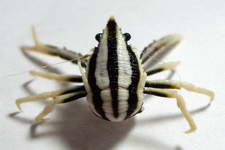
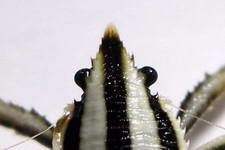
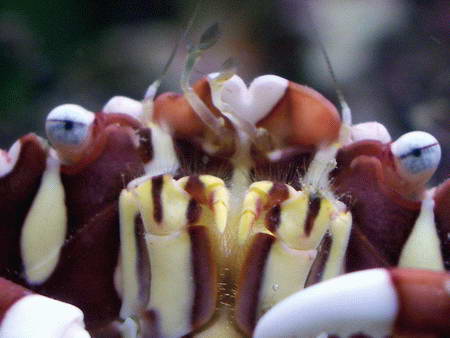
The Dromiidae Crabs - Specializes in carrying sponges and even zoanthids as a means of camouflage, it does so by means of its last set of legs which are modified to grasp onto its captive audience. I have had this specimen drop its sponge and snip out a square inch section of zoanthids off of their rock and form the zoanthids into the same shape as the sponge pictured below. I have seen others on the reef slopes carrying about both sponges and zoanthids in this manner.

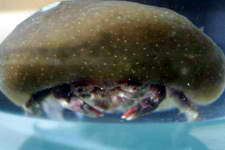

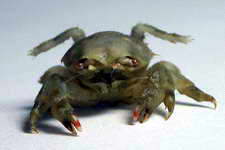
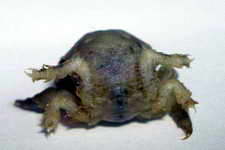

The Portunidae ( Swimming Crabs) Note the paddle shaped last pair of legs.
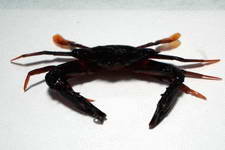
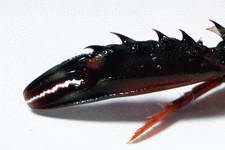
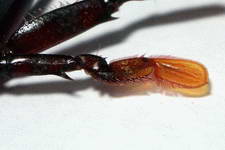
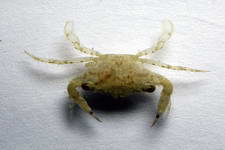

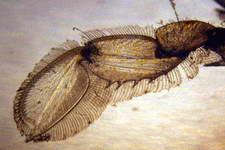
Below: A Lissocarcinus laevis, a symbiont of sea anemone.
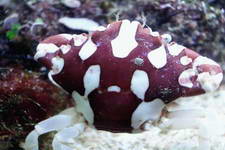

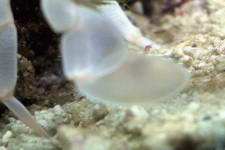
Below: Various other species
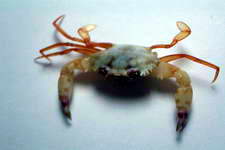
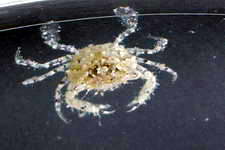
The Majoidea SuperFamily ( spider crabs / decorator crabs)
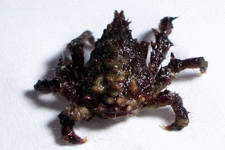

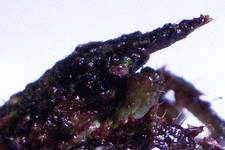
Below: Xenocarcinus tuberculatus A member of the Pisidae family
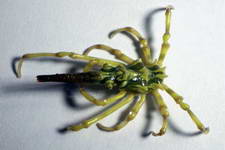
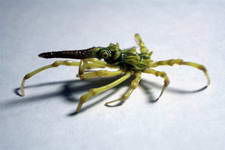

Below: Achaeus japonicus
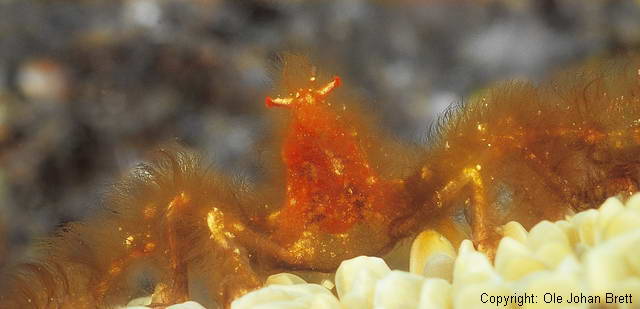
Below: Various other unknown species

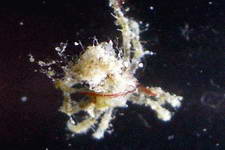
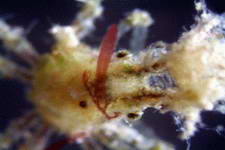
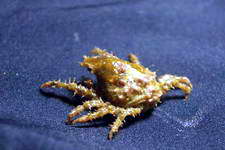
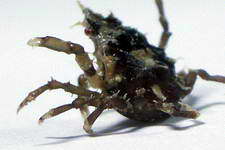
The Parthenopidae Family, commonly called the elbow crabs. Below is a possible Daldorfia horrida.
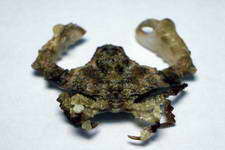

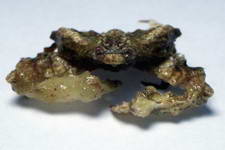
Below, possibly a juvenile Daldorfia glasselli.
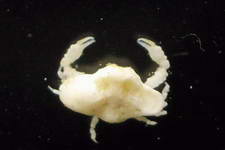
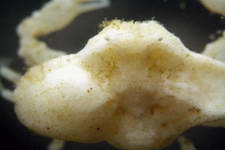
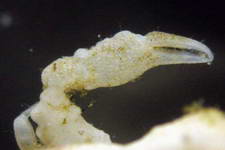
The Calappa Crabs ( box crabs )
Gravid Female Ready to hatch eggs Two day old Larvae
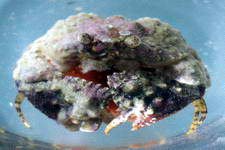
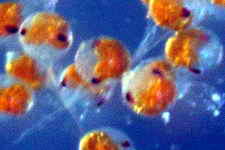
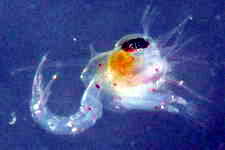
The Leucosiidae Crabs ( Pebble Crabs)
Below, a member of the Leucosia genus
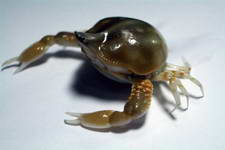
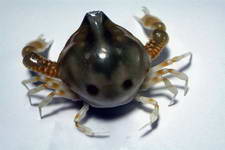
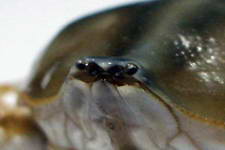
The Cryptochirid Crabs ( Gall Crabs )
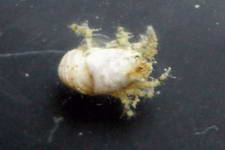
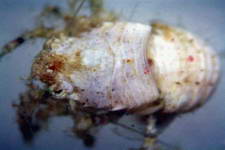
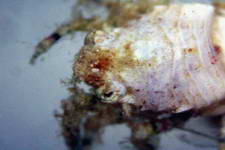
The Pinnotheridae Crabs ( Pea Crabs) - Pea crabs are commensals that associate with various echinoderms, molluscs, polychaetes, brachiopods, etc. Some are external while many of them are internal living inside their hosts' gill chambers or body cavities. (photos by Beth LeBlanc)
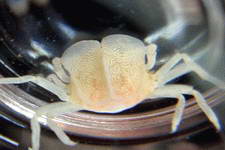
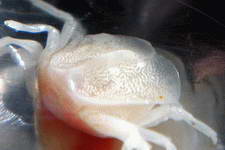
The Stenorhynchus Crabs ( arrow crabs ) Normally not considered reef aquarium safe
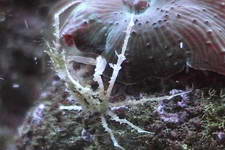



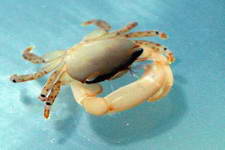
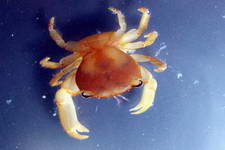
Trapezia digitalis Tetralia sp. Tetralia glaberrima
Specimen #4 Specimen #5 Specimen #6
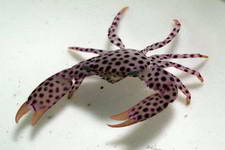
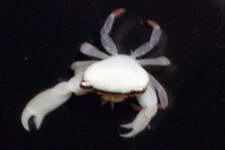

Trapezia rufopunctata Tetralia nigrolineata Tetralia cymodoce
Specimen #7 Specimen #8 Specimen #9

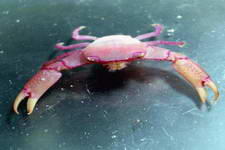
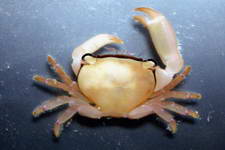
Trapezia guttata Trapezia serenei Tetralia nigrolineata
Specimen #10 Specimen #11 Specimen #12
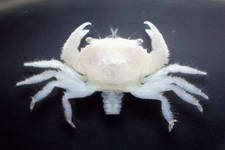
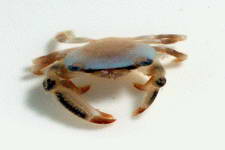
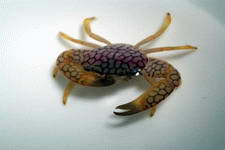 Jonesius triunguiculatus Tetralia cinctipes Trapezia septata
Jonesius triunguiculatus Tetralia cinctipes Trapezia septata
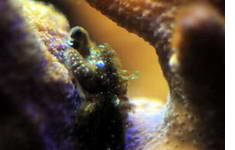
Cymo andreossyi : Very common and is considered a coral symbiont, with the caveat that such symbiosis are a trade off between the coral and the crab, the coral gains protection and house cleaning services while giving up a few polyps, mucus and captured/settled food particles in exhange for those services. A healthy coral should have no problem repairing or replacing lost polyps, but again, in an aquarium environment, an eye should be kept on the coral for excessive damage being done due to the coral being unable to recover as fast or faster than the damage being done by the crab. In short, its a judgement call that you will have to make.
Trapeziid Crabs of New Caledonia, Eastern Australia and the Coral Sea
Below, a commonly found Xanthid species living within live rock.



Below, yet another rock living Xanthid species.



Below is a Xanthid species found on Acropora corals and assume they prey upon the corals polyps or tissue.



Various other Xanthid species.





The Hermit Crabs Hermit ID site Paguritta Hermit Crab


The Mithrax Crabs ( Cling Crabs) None of which I would consider to be reef safe, members of this family include the popular "emerald" crabs that are used for algae control, which may be fine for awhile, but with all crabs being omnivores, it is usually only a matter of time before these crabs discover that there are meatier items to be had within your aquarium.












The Porcellanidae Crabs Photo Link #2 Photo Link #3 Can be considered Reef Aquarium Safe









The Anomuran crabs, part of the Porcellanidae family, relatives of Petrolisthes and Porcellanella.



Petrolisthes species


The Galatheid Crabs - Also known as squat lobsters for their appearing very lobster like. All of the species that I have found on live rock have been very small and seem to be somewhat harmless, although they may feed upon small sessile invertebrates.









The Allogalatheid Crabs - also known as squat lobsters but only lives on crinoids. Color patterns usually consists of alternating dark & light colored bands with white leg tips & claws; the colors always match the host crinoid. They are klepto-parasites that don't directly harm the host but steal its food.
Allogalathea elegans




The Dromiidae Crabs - Specializes in carrying sponges and even zoanthids as a means of camouflage, it does so by means of its last set of legs which are modified to grasp onto its captive audience. I have had this specimen drop its sponge and snip out a square inch section of zoanthids off of their rock and form the zoanthids into the same shape as the sponge pictured below. I have seen others on the reef slopes carrying about both sponges and zoanthids in this manner.






The Portunidae ( Swimming Crabs) Note the paddle shaped last pair of legs.






Below: A Lissocarcinus laevis, a symbiont of sea anemone.



Below: Various other species


The Majoidea SuperFamily ( spider crabs / decorator crabs)



Below: Xenocarcinus tuberculatus A member of the Pisidae family



Below: Achaeus japonicus

Below: Various other unknown species





The Parthenopidae Family, commonly called the elbow crabs. Below is a possible Daldorfia horrida.



Below, possibly a juvenile Daldorfia glasselli.



The Calappa Crabs ( box crabs )
Gravid Female Ready to hatch eggs Two day old Larvae



The Leucosiidae Crabs ( Pebble Crabs)
Below, a member of the Leucosia genus



The Cryptochirid Crabs ( Gall Crabs )



The Pinnotheridae Crabs ( Pea Crabs) - Pea crabs are commensals that associate with various echinoderms, molluscs, polychaetes, brachiopods, etc. Some are external while many of them are internal living inside their hosts' gill chambers or body cavities. (photos by Beth LeBlanc)


The Stenorhynchus Crabs ( arrow crabs ) Normally not considered reef aquarium safe



Presented by Charles & Linda Raabe
Mactan Island, The Philippines
© 2009 All Rights Reserved
" Stony corals are the foundation of coral reef ecosystems and form associations
with other reef species. Many of these associations may be ecologically
important and play a role in maintaining the health and diversity of reef
systems, rendering it critical to understand the influence of symbiotic
organisms in mediating responses to perturbation. This study demonstrates the
importance of an association with trapeziid crabs in reducing adverse effects of
sediments deposited on corals. In a field experiment, mortality rates of two
species of branching corals were significantly lowered by the presence of crabs.
All outplanted corals with crabs survived whereas 45-80% of corals without crabs
died within a month. For surviving corals that lacked crabs, growth was slower
and tissue bleaching and sediment load were higher. Laboratory experiments
revealed that corals with crabs shed substantially more of the sediments
deposited on coral surfaces, but also that crabs were most effective at removing
grain sizes that were most damaging to coral tissues. The mechanism underlying
this symbiotic relationship has not been recognized previously, and its role in
maintaining coral health is likely to become even more critical as reefs
worldwide experience increasing sedimentation. "
It is our hope that by documenting the coral and crab species
found as commensals we can help to determine which crab species should
be targeted for breeding efforts. If we are to ever transplant any of
the branching corals out onto the reefs as a restoration project, we
will have to include a variety of coral crab species as well.Click Links to view photographic details
Specimen #1 Specimen #2 Specimen #3


Trapezia digitalis Tetralia sp. Tetralia glaberrima
Specimen #4 Specimen #5 Specimen #6



Trapezia rufopunctata Tetralia nigrolineata Tetralia cymodoce
Specimen #7 Specimen #8 Specimen #9



Trapezia guttata Trapezia serenei Tetralia nigrolineata
Specimen #10 Specimen #11 Specimen #12




Cymo andreossyi : Very common and is considered a coral symbiont, with the caveat that such symbiosis are a trade off between the coral and the crab, the coral gains protection and house cleaning services while giving up a few polyps, mucus and captured/settled food particles in exhange for those services. A healthy coral should have no problem repairing or replacing lost polyps, but again, in an aquarium environment, an eye should be kept on the coral for excessive damage being done due to the coral being unable to recover as fast or faster than the damage being done by the crab. In short, its a judgement call that you will have to make.
Related Reading
Four New Species of Coral Crabs DiscoveredTrapeziid Crabs of New Caledonia, Eastern Australia and the Coral Sea
Identifications made by:
Sandy Trautwein
Peter Castro, Ph.D.
Curator of Fish and Invertebrates Biological Sciences Department
Aquarium of the Pacific in Long Beach Ca. California State Polytechnic University
Download a .pdf version of the publication shown below
Every Crab in the World
(click above link)
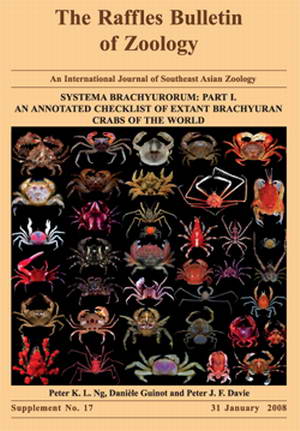
Curator of Fish and Invertebrates Biological Sciences Department
Aquarium of the Pacific in Long Beach Ca. California State Polytechnic University
Download a .pdf version of the publication shown below
Every Crab in the World
(click above link)

Please take a moment and consider supporting any one of the projects listed within. Thank you.
All content and photographs are CopyRight Protected
and may not be used ,copied or reproduced elsewhere
without permission of the authors.
and may not be used ,copied or reproduced elsewhere
without permission of the authors.
Visitor Count
since 24 Jan.08

